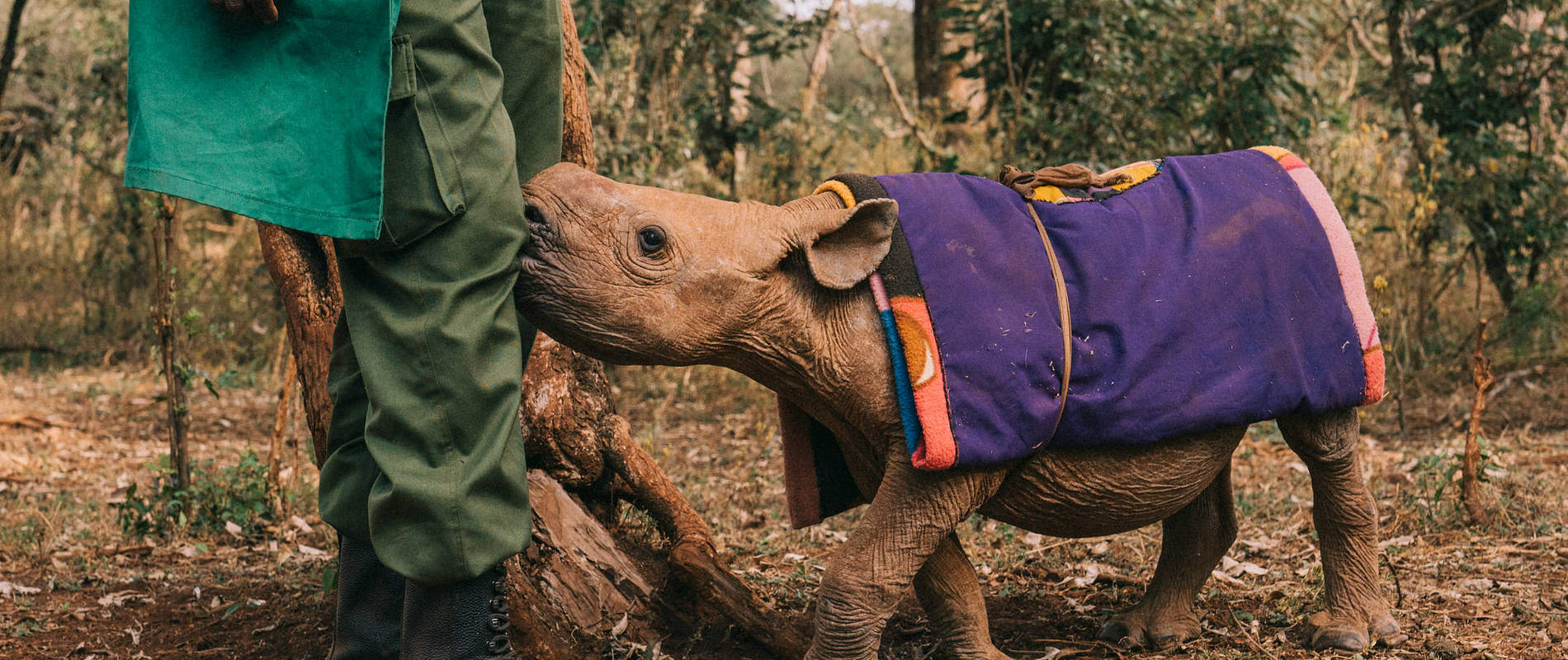Today, we are celebrating joy. World Rhino Day falls on an auspicious date: Exactly one year ago (plus one day, but who’s counting), Raha the rhino came into our world. Her name, which means ‘joy’ in Swahili, is a fitting word to associate with this brave little rhino. Much like her species as a whole, Raha has overcome enormous odds to be here today.

Raha’s story began in Ol Pejeta, a stronghold for black rhinos in Kenya. On the afternoon of 23rd September 2022, Ol Pejeta Conservancy scouts reported a black rhino calf who had been abandoned. Exactly why remains a mystery — perhaps her mother rejected her, or she could have gotten into an altercation with another rhino and her calf was cast aside in the process. In the short time she had been on her own, predators had attacked the orphan, leaving her with extensive internal and external injuries to her rear end.

Given all she had been through, Raha’s chances of survival looked slim. One thing was certain: She needed urgent veterinary intervention — not to mention round-the-clock care — if she was to have a shot. With the consent of Ol Pejeta management, KWS green-lit a rescue and the calf was brought to our Nairobi Nursery. We have a long history of raising orphaned rhinos in this safe, supportive environment. Nairobi National Park, the wilderness into which they are ultimately reintegrated, is home to a thriving population of wild black rhinos.

Raha’s early days at the Nursery were very touch-and-go. The predators had chewed through to the tailbone, mutilating her rear end in the process. Painstaking veterinary intervention rebuilt Raha’s netherregions, but the healing process came with inevitable digestive challenges. We had to tread very carefully with her diet, and understandably, Raha was reluctant to eat solids. As a result, she remained very small and thin for her age.

Despite her precarious state, Raha’s spirit never wavered. Swaddled in her bright blanket, the tiny rhino quickly assumed control of the Nursery. From sunup to sundown, she toddled step-in-step with her Keepers, chattering away with a series of squeaks. Her little button nose — which, in the fullness of time, will morph into an impressive horn — was like a detective’s magnifying glass, inspecting and investigating every curious object that crossed her path.

Raha’s healing journey had a major breakthrough in July, nine months after her rescue. One morning, without preamble, she started munching on lucerne and greens as if it was her everyday habit. She discovered that she had a voracious appetite, and the effect was instantaneous: Raha started to put on weight and bulk up, transforming into a miniature version of the sturdy rhino silhouette we all know so well.

We have noticed one major ripple effect of Raha’s newly expanded diet: As she has grown bigger and stronger, her confidence has increased, too. In the past, she shied away from the wild warthogs that enjoy following her around. They’re harmless, but their presence used to make Raha uneasy. She dislikes anyone walking behind her, probably due to lingering memories from the predator attack. But now, instead of scampering away from the warthogs, she turns around and faces them head-on. Rhinos are territorial by nature, and it is a wonderful development that Raha is feeling ready to defend her tiny territory.

Raha has overcome so much in the past year. It is easy to forget that her journey is just beginning. In the coming years and decades, Raha will grow up and reclaim her place in the wild, joining the resident black rhino population of Nairobi National Park. She will follow in the footsteps of Solio, a female orphaned black rhino who is now living wild and a mother of two. Miraculously, the predators didn’t destroy Raha’s reproductive orphans, so it is our greatest hope that she too will grow up to have her own family.

Any addition to the black rhino population is noteworthy: While the species once flourished across the African continent, rampant poaching decimated their numbers. In Kenya, the black rhino population suffered a catastrophic 98 percent decline between 1970 and 1983, dwindling from 20,000 to just 350 individuals in the span of just over a decade.

Much like Raha, the odds were stacked against them — but hope prevails. Dedicated field conservation efforts and global support have brought black rhino populations back from the brink. Today, Kenya is a stronghold for the species, home to well over 900 individuals. They are still critically endangered, but each individual serves as a beacon of hope.

Because of donor support, we are able to protect wild rhinos across Kenya, secure the habitats they call home, and rescue the orphans left behind. On World Rhino Day — and every day — we thank you for making this essential conservation work possible. Your support enables us to save one precious life and secure a future for an entire species.
